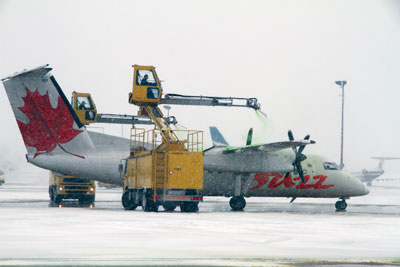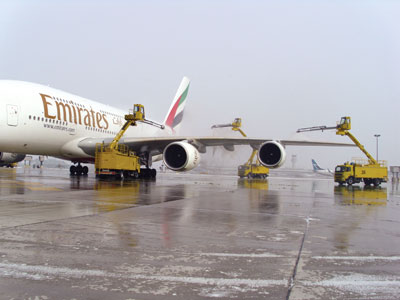
Features
Safety
Clearing a safer path
In a country “blessed” with frigid winter conditions for a good portion of the year, it’s not surprising aviation firms and universities studying the effects of winter conditions on aircraft have plenty of examples to work with.
March 22, 2012 By Peter Pigott
In a country “blessed” with frigid winter conditions for a good portion of the year, it’s not surprising aviation firms and universities studying the effects of winter conditions on aircraft have plenty of examples to work with.
 |
|
| With winter operations, a pilot’s focus of attention shifts to runway conditions, and stopping criteria is paramount. Photo: M.Chaput
|
And as Dr. Michael W. Holm, the technical officer, ICAO Meteorology Division aptly noted at the recent Winter Ops 2011 conference, most of the research reveals that “snow and planes don’t mix.” Holm might have continued that statement to note that the combination of ice and planes could be fatal.
Sponsored by the Flight Safety Division (FSD) of the Air Canada Pilots Association (ACPA), the International Winter Operations Conference was held last Oct. 5-6 in Montreal. Under the theme of “Safety is No Secret,” some 250 delegates from 18 countries came together to share their expertise in operating safely in winter conditions.
Led by two eminently qualified pilots, ACPA president captain Paul Strachan and FSD chairman captain Barry Wiszniowski, the conference brought together experts from around the world – aircraft and power plant manufacturers, pilots, air traffic controllers, de-icing service providers and safety investigators – to share their experience in safe winter operations, specifically de-icing.
The presentations ranged from operations in active frost conditions, to implementing takeoff and landing performance assessments, to ice in the fuel, to cold weather testing – all interspersed with panel discussions. And while all sessions were informative and noteworthy, none could match the immensity of author Allan J. McDonald’s presentation from his book Truth, Lies and O-Rings: Inside the Space Shuttle Challenger Disaster, which opened the conference. More than whistle blowing on the aerospace industry, it was a warning on lessons still unlearned on de-icing.
“Over the past 25 years, a number of fatal aircraft accidents have been attributed in part, to ice formation on the ground, prior to takeoff,” said Arlene Beisswenger, a consultant at the Anti-icing Materials International Laboratory at the Université du Québec à Chicoutimi. And indeed, one could not escape the seminal tragedy that focused attention on ice and snow: the Dryden air crash.
 |
|
| A Vestergaard Beta de-icing vehicle about to commence activities in a heavy snow event. Photo: M.Chaput
|
On March 10, 1989, an Air Ontario Fokker F-28 Mk 1000 with 65 passengers and crew of three crashed off the end of the runway at Dryden, Ont. The captain had not done a proper “walk-around” or asked for de-icing, and by the time the aircraft took off, the half inch of wet snow on the wings had turned into opaque ice. Twenty-one passengers and three crew members were killed.
Occurring soon after the Arrow Air crash at Gander (256 U.S. military personnel were killed), the Dryden tragedy led to the scrapping of the investigating agency the Canadian Aviation Safety Board and the appointing of a Commission of Inquiry under the Honorable Virgil Moshansky. His report – and specifically the findings regarding ice build-up on the wings – led to a better technical understanding of this phenomenon, and made Canada a world leader today in preventive measures.
“The de-icing industry has come a long way since the Dryden incident,” Aeromag 2000’s director Denis Gordon said. “Regulation changed from inspection to training. People don’t realize all the work and effort that is now done behind the scene – the testing of all glycol products, holdover time charts that are revised annually, standards and procedures that are updated prior to the next de-icing season.”
Meeting annually, the SAE G12 Aircraft Ground De-icing Committee of de-icing experts, aircraft manufacturers and regulators from around the world, address all areas of ground de-icing procedures. “What is good about a committee like the G12,” Gordon said, “is the more information we have available, the better we are able to train the people that are involved in the day-to-day de-icing operations.”
Leading the way
Canada is fortunate to have two academic institutions that are world leaders in the science of de-icing. Established in 1994, the Anti-Icing Materials International Laboratory (AMIL) at the Université du Québec à Chicoutimi studies and simulates ice formation. AMIL is the only laboratory in the world, Beisswenger said, that is accredited to qualify de-icing and anti-icing fluids used to protect airplanes prior to takeoff for icing protection and aerodynamic acceptance. Clients range from Dow Chemical Company to China’s Beijing Aviation.
 |
|
| An Airbus A380 gets de-iced by Servisair personnel at the central de-icing facility at Toronto’s Pearson International Airport. Photo: Servisair
|
AMIL operates five cold chambers capable of simulating freezing rain, drizzle and fog, frost, snow and ice pellets. To simulate medium and strong winds, or to reproduce aircraft flight conditions, or in-cloud icing and freezing fog, AMIL uses two low-speed wind tunnels that can be operated at subfreezing temperatures. Other specialized equipment includes different apparatuses to measure the adhesion of ice by centrifuge, flexion, torsion or traction. With such world-class facilities, Beisswenger and her team manage research projects for airlines relating to de-icing and developing tests in freezing precipitation simulation.
From the University of Waterloo’s Department of Civil and Environmental Engineering, Dr. Susan Tighe, P.Eng., is the Canada Research Chair in Pavement and Infrastructure Management. Said Tighe: Measuring the surface conditions of a runway and properly assessing the wheel-braking capability is crucial in the planning for the safe landing or takeoff of an airplane, especially when the runway is contaminated during heavy rainstorms or snow/ice during the winter.”
None of the commercially available friction measurement devices take the aircraft Anti-Skid Braking System (ASBS) into account in measuring runway surface characteristics. As a consequence, Tighe helped develop a new system to more accurately predict the braking performance of an aircraft by mimicking its actual stopping characteristics as closely as possible – and the first prototype machine has already been tested.
“With winter operations, a pilot’s focus of attention shifts to runway conditions, and stopping criteria is paramount,” said Bryon Mask, president of CORANNA Flight Safety Investigative Services. Mask discussed the use of routine Flight Data Analysis (FDA) and its value in improving overall safety.
“Winter conditions often influence variations in stable approach criteria, single-engine taxi procedures, use of reverse thrust and gate wait events as examples,” he said. With a sophisticated FDA program in place, an airline would be able to ascertain seasonal variations within their event set (flight safety measurements). A comprehensive parameter set with a programmer and flight data analyst is a necessity and Applied Informatics and Research Inc. can provide a realistic event playback capability suited to an airline’s needs.
“How much fan and spinner ice build up is acceptable before de-icing the engine?” asked Andy Mihalchik, flight operations from GE Aviation? Mihalchik discussed engine operations from the flight crew perspective. When engine de-icing is not an option, the ice shed procedure must be accomplished, he warned, early on taxi-out. And spraying aircraft de-icing fluid into the engine is not approved.
“Dryden was certainly a wake-up call,” said Michael Chaput, president of Montreal-based Deicing Innovations, a firm that assists other aviation organizations with the design and implementation of customized de-icing strategies. “Since then, Transport Canada has played a leading role in funding ground de-icing research and the end result is a national system of air carriers, airports, de-icing service providers, centralized de-icing facilities and subject matter experts that is the envy of the world.”
To prove his point, Chaput mentioned companies such as Dan-Ice Canada, Chinook Mobile Heating and Deicing Corporation, and AIM Systems – all leaders in their field. Dan-Ice Canada has already implemented automated holdover time determination systems at Calgary, Toronto and Montreal airports, and currently has a commercial contract with Westjet. These systems measure meteorological conditions and send electronic de/anti-icing fluid holdover time reports right to the flight deck, allowing the pilots to make correct de-icing decisions.
Chinook Mobile Heating and Deicing Corporation of Smiths Falls, Ont., has just signed its first commercial contract with Finnair for its non-glycol de-icing system for aircraft and engine fan blades that uses heated, moisture-laden air as a medium. And in addition to Toronto and Vancouver, Amsterdam’s Schiphol Airport will soon have AIM Systems advanced LED-based electronic message boards for its airport and de-icing operations.
As ACPA director of communications Paul Howard noted, the purpose of Winter Ops 2011 was to share Canadian expertise in winter conditions with the rest of the world. It certainly accomplished its goal and underscored the importance of this important segment in Canadian aviation – an absolute necessity especially given our harsh and unpredicable climate.
| Learning through tragedy On Jan. 21, 1995, another tragic aviation event occurred on Canadian soil that ultimately shaped the way current de-icing activities are performed in Canada and on the global scale. On this day, a Boeing 747-400, registration CN-RGA, operated by Royal Air Maroc, was preparing for a scheduled flight from Mirabel International Airport (YMX), Que., to Casablanca, Morocco, with a stop in New York City. The aircraft was parked in the de-icing centre at the airport. The four engines were running during the de-icing operation. The flight crew heard “dégivrage terminé” (de-icing completed), and the captain asked the co-pilot to inform the apron controller that the aircraft was ready to taxi. Taxi instructions were issued. The aircraft started to move forward and overturned the two de-icing vehicles that were still in front of the aircraft’s horizontal stabilizers. The two vehicle drivers sustained minor injuries; the three occupants of the cherry-pickers received fatal injuries. The Transportation Safety Board of Canada determined that the flight crew started to taxi the aircraft before its perimeter was clear, following confusion in the radio communications. The following factors contributed to the accident:
The fallout of the Mirabel accident resulted in widespread changes on the global scale to de-icing facility procedures, engines-on de-icing procedures, communication and radio protocols. Even today, the Mirabel accident is cited to reinforce the need for visual hold procedures to enhance verbal communication procedures in engines-on de-icing operations. |